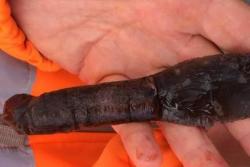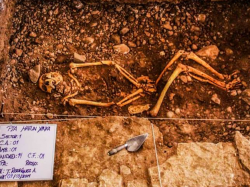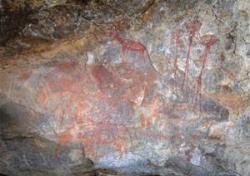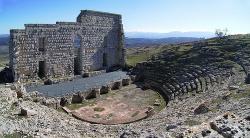INSTITUT SUPERIEUR D'ANTHROPOLOGIE
INSTITUTE OF ANTHROPOLOGY
ONLINE COURSES / COURS A DISTANCE
WINTER TERM : JANUARY 2015
REGISTER NOW
DANEMARK –  Rødby - A flint-bladed knife with a wooden handle has been found in an archaeological dig in Rødby in southern Zealand. It is the first such knife ever found in Denmark and it is at least 3,000 years old. While Stone Age flint knives are a somewhat common find, finding a flint knife with a wooden handle, an improvement that first appeared in the Bronze Age (which fizzled out in about 1200 BC), has never happened before. As people transitioned from flint to bronze tools, the supply of bronze often could not keep up with the demand for the metal, so artisans sometimes made knives that combined new designs with old materials such as a Bronze Age knife with a flint blade.Knife owners typically kept a knife until they died, often being buried with it. The 20 centimetre long specimen unearthed this week was found in an old seabed. The knife is on its way to the national museum in Copenhagen. Similar knives have been found in Germany, and researchers hope that a detailed study of the blade and handle will tell them more about the knife's origins and links between Denmark and Germany during the time it was made.
Rødby - A flint-bladed knife with a wooden handle has been found in an archaeological dig in Rødby in southern Zealand. It is the first such knife ever found in Denmark and it is at least 3,000 years old. While Stone Age flint knives are a somewhat common find, finding a flint knife with a wooden handle, an improvement that first appeared in the Bronze Age (which fizzled out in about 1200 BC), has never happened before. As people transitioned from flint to bronze tools, the supply of bronze often could not keep up with the demand for the metal, so artisans sometimes made knives that combined new designs with old materials such as a Bronze Age knife with a flint blade.Knife owners typically kept a knife until they died, often being buried with it. The 20 centimetre long specimen unearthed this week was found in an old seabed. The knife is on its way to the national museum in Copenhagen. Similar knives have been found in Germany, and researchers hope that a detailed study of the blade and handle will tell them more about the knife's origins and links between Denmark and Germany during the time it was made.
http://cphpost.dk/news/rare-bronze-age-knife-discovered-in-southern-zealand.11165.html?
PEROU –  Hatun Xauxa - According to Peru’s Ministry of Culture, archaeologists have discovered remains in the Inca administrative center, Hatun Xauxa. Experts unearthed human burial sites and painted walls believed to date back to the ancient city’s first period of construction. “These findings allow us to gauge the religious importance and the complex nature of activities in the ushnu of Hatun Xauxa,” the ministry reported. Located in the central region of Junin, near the city of Jauja, the ancient Hatun Xauxu city has been under investigation by researchers for some time. It plays home to the so-called “well of liquid offerings” found in the sacred throne or “ushnu”. It is believed that Incas poured liquor made from maize and other products as part of ceremonial activities. The ancient settlement sits upon a hill, a few kilometers from the city of Jauja.
Hatun Xauxa - According to Peru’s Ministry of Culture, archaeologists have discovered remains in the Inca administrative center, Hatun Xauxa. Experts unearthed human burial sites and painted walls believed to date back to the ancient city’s first period of construction. “These findings allow us to gauge the religious importance and the complex nature of activities in the ushnu of Hatun Xauxa,” the ministry reported. Located in the central region of Junin, near the city of Jauja, the ancient Hatun Xauxu city has been under investigation by researchers for some time. It plays home to the so-called “well of liquid offerings” found in the sacred throne or “ushnu”. It is believed that Incas poured liquor made from maize and other products as part of ceremonial activities. The ancient settlement sits upon a hill, a few kilometers from the city of Jauja.
http://www.peruthisweek.com/news-important-archaeological-remains-found-in-junin-104148
ROYAUME UNI –  Scilly - The archaeologist who oversaw this summer’s second excavation on St Martin’s says his team is unlikely to return next year, even though the Old Quay is one of the most significant Neolithic sites in the UK. Reading University’s Dr Duncan Garrow led a team of ten people who uncovered around 4,000 shards of pottery and 11,000 flints dating back as far as 3,500 BC. Finds included a rare ‘mace head’ axe. Duncan says the amount of material is “massive” and “only a small portion of the site has been dug.” The work confirms settlement occurred in Scilly at an earlier period that previously thought. The team found 30 postholes, which might have been part of structures from settlements stretching back to 3,500 years BC. He says they don’t form a neat pattern so might indicate either temporary buildings or several different structures overlaying each other at different periods. And those inhabitants, like many people living in Scilly today, could have been seasonal, making a precarious crossing in a sail-free, skin-shelled boat. Duncan says it is unlikely that there will be any move to get the site legally protected as most of the archaeology is under the ground. The land usage is low intensity so it isn’t under human threat although coastal erosion is an issue, as it is in many places in Scilly.
Scilly - The archaeologist who oversaw this summer’s second excavation on St Martin’s says his team is unlikely to return next year, even though the Old Quay is one of the most significant Neolithic sites in the UK. Reading University’s Dr Duncan Garrow led a team of ten people who uncovered around 4,000 shards of pottery and 11,000 flints dating back as far as 3,500 BC. Finds included a rare ‘mace head’ axe. Duncan says the amount of material is “massive” and “only a small portion of the site has been dug.” The work confirms settlement occurred in Scilly at an earlier period that previously thought. The team found 30 postholes, which might have been part of structures from settlements stretching back to 3,500 years BC. He says they don’t form a neat pattern so might indicate either temporary buildings or several different structures overlaying each other at different periods. And those inhabitants, like many people living in Scilly today, could have been seasonal, making a precarious crossing in a sail-free, skin-shelled boat. Duncan says it is unlikely that there will be any move to get the site legally protected as most of the archaeology is under the ground. The land usage is low intensity so it isn’t under human threat although coastal erosion is an issue, as it is in many places in Scilly.
http://www.scillytoday.com/2014/10/08/st-martins-neolithic-site-unlikely-to-see-more-excavation-soon/
TANZANIE –  Kondoa - Kondoa Irangi Rock Paintings in Kondoa District in central Tanzania are one of the most recognizable rock art complexes in Africa. Thousands of paintings under overhanging rock depict a variety of themes, showing both scenes from the life of hunters and gatherers, as well as later settlers. One of the first scientists to study them was archaeologist and paleontologist Louis Leakey, who was searching for the oldest ancestors of humans in the Olduvai gorge nearby. In 2006, the site became a UNESCO World Heritage Site, but the paintings are still poorly understood by scientists. Polish researcher wants to expand the existing database of images visible on the rocks. To this end, he will work with Rock Art Conservation Centre in Arusha."My project combines archaeology and ethnology. It turns out that in many places rock art still has an important religious role for local communities Sandawe and Hadza" - Maciej Grzelczyck told PAP. According to the researcher, only by using the methodology of both disciplines it will be possible to understand the rock art. Grzelczyck draws attention to the fact that about many paintings of Kondoa District little more is known than that they exist and had been painted for thousands of years. Some of the paintings were used in hunting magic and fertility and rain rituals. At this moment, it is even unclear how many paintings there are.
Kondoa - Kondoa Irangi Rock Paintings in Kondoa District in central Tanzania are one of the most recognizable rock art complexes in Africa. Thousands of paintings under overhanging rock depict a variety of themes, showing both scenes from the life of hunters and gatherers, as well as later settlers. One of the first scientists to study them was archaeologist and paleontologist Louis Leakey, who was searching for the oldest ancestors of humans in the Olduvai gorge nearby. In 2006, the site became a UNESCO World Heritage Site, but the paintings are still poorly understood by scientists. Polish researcher wants to expand the existing database of images visible on the rocks. To this end, he will work with Rock Art Conservation Centre in Arusha."My project combines archaeology and ethnology. It turns out that in many places rock art still has an important religious role for local communities Sandawe and Hadza" - Maciej Grzelczyck told PAP. According to the researcher, only by using the methodology of both disciplines it will be possible to understand the rock art. Grzelczyck draws attention to the fact that about many paintings of Kondoa District little more is known than that they exist and had been painted for thousands of years. Some of the paintings were used in hunting magic and fertility and rain rituals. At this moment, it is even unclear how many paintings there are.
http://www.naukawpolsce.pap.pl/en/news/news,402077,the-first-polish-archaeological-project-in-tanzania.html
ESPAGNE –  Acinipo - One of Andalucia’s most important cultural sites, the Roman ruins has been added to a ‘red list’ of at-risk assets by non-profit association Hispania Nostra. Dating back to the first century BC, Acinipo was a city created for retired soldiers from Caesar’s Roman legions. Just 20km from Ronda, the Ibero-Roman settlement – which includes a Roman theatre still in use today – is known locally as Ronda la Vieja, or Old Ronda. But constant pillaging, progressive deterioration and no conservative action from the Junta is said to be putting the site in jeopardy.
Acinipo - One of Andalucia’s most important cultural sites, the Roman ruins has been added to a ‘red list’ of at-risk assets by non-profit association Hispania Nostra. Dating back to the first century BC, Acinipo was a city created for retired soldiers from Caesar’s Roman legions. Just 20km from Ronda, the Ibero-Roman settlement – which includes a Roman theatre still in use today – is known locally as Ronda la Vieja, or Old Ronda. But constant pillaging, progressive deterioration and no conservative action from the Junta is said to be putting the site in jeopardy.
http://www.theolivepress.es/spain-news/2014/10/08/rondas-roman-ruins-future-in-jeopardy-says-spanish-heritage-group/?
BULGARIE –  Kastra Rubra - Archaeologists have uncovered a unique for Bulgaria medallion with spiralled snake heads in an excavation at the Kastra Rubra fortress, near Harmanli, reports Dnes.bg. The dig started a month ago and ended on October 7. The team of professor Boris Borisov found more than 170 artifacts, more than half of which are coins. “The site is very rich,” he told journalists. “For three years we found 500 items. We have coins from the early Byzantine Empire, a clay stamp, iron belt buckles, other belt ornaments.” According to Borissov, the early Byzantine fortress, which his team studies, is part of a huge complex, which includes two necropolises and the Kastra Rubra way station, mentioned in II c. A.D. manuscripts.
Kastra Rubra - Archaeologists have uncovered a unique for Bulgaria medallion with spiralled snake heads in an excavation at the Kastra Rubra fortress, near Harmanli, reports Dnes.bg. The dig started a month ago and ended on October 7. The team of professor Boris Borisov found more than 170 artifacts, more than half of which are coins. “The site is very rich,” he told journalists. “For three years we found 500 items. We have coins from the early Byzantine Empire, a clay stamp, iron belt buckles, other belt ornaments.” According to Borissov, the early Byzantine fortress, which his team studies, is part of a huge complex, which includes two necropolises and the Kastra Rubra way station, mentioned in II c. A.D. manuscripts.
http://www.novinite.com/articles/163955/Archaeologists+Uncover+Unique+Medallion+Near+Bulgaria%27s+Harmanli?